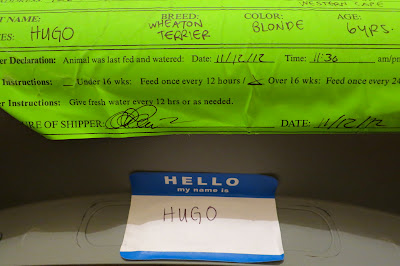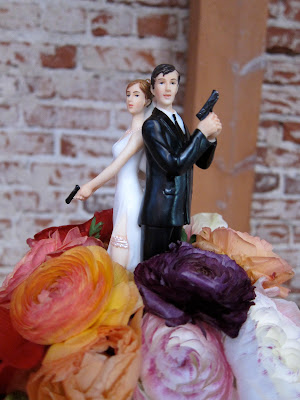 |
| Grandfather as "Prison Dog" in Pirates of the Caribbean |
My mom was a small town girl and was likely wooed by some
rich Baltimore city slicker who charmed her pants off (not that she was wearing
any to begin with). Anyway, I don’t know him, but some said he was
handsome. There have been a few
times when I thought I saw him—in a park,
on a Travelers Insurance commercial or passing on the street—our eyes
meet briefly as if looking into a reflection, but I just kept walking and so did
he.
She became pregnant and her caretaker, the local drug
dealer, made an untimely visit to prison, which left her out on the
street. She, ever brave and
strong, had my siblings and me somewhere along Deal Island Road. I guess if one is born in Deal Island,
you are born on one side of Deal Island Road or the other. Within a couple of months, I took to
catching flies and digging for razor clams. Drinking from the stream was one of
my favorite past times until a ornery little turtle bit the end of my nose—scared
the bejesus out of me. I’m on guard every time I sip water, even out of my
bowl. And I don’t go near toilets.
We lived in the woods & wetlands for a few months and
then my mom got the call. She went back to the drug dealer and we followed, as
we tend to do. Before we knew it,
we were in the back of a pick-up truck headed for New Jersey to be sold,
leaving my mother behind. As she
faded into the distance, I sighed and resigned myself to the bed of the truck.
We stopped for fuel at Lucky’s and as my brothers and sisters milled about, I
propped myself up on the wheel well as something caught my eye. It was a yellow
bug—they always came out with the sunshine and I was obsessed with them. So, I
hopped over the edge and chased after it into the woods. A month later, I was
found behind Lucky’s, just a wee bit skinny for my own good. I discovered that
the yellow bugs are immune to being caught and flies provide only small amounts
of protein. I was also really thirsty, for obvious reasons.
 |
| Jamaica Pond in Jamaica Plain, MA |
I spent the night in a bathroom of a nice woman’s house. The
next day, her Aunt Becca opened the door and put me in her car. We drove 8 hours to Boston and I slept
the whole way. I spent the next
few days in her kitchen. On the third morning, I heard the front door open and
peeped around the corner. There she was, a young woman with long brown hair and
rosy cheeks, just smiling at me.
With head bowed and tail wagging, I bounded towards her. She sat down on
the kitchen floor and I sat in her lap and just leaned into her, my new mom. I
was home.
 |
| Me in training. This one is called "Circus". |
We went for lots of walks around Jamaica Pond. She let me
chase the ducks, but only sometimes. She never let me chase the white
squirrel—said it was too risky—even though I have never caught a squirrel in my
life. She taught me a lot of things about the difference between greeting
people versus greeting dogs. She taught me how to sit, spin, hide, and how to
tell between my right and left paws. She’s tried to help me work through my
fear of reflective water bowls, but she understands the trauma of turtles and
promised never to bring one into the house. She says that I have taught her a
lot about life…about letting go, being present, savoring every treat, walking
slower, running faster, dreaming loudly, and how to give more hugs.
She has left me a couple of times claiming that it was too
complicated to bring me along. And I missed her, but being the present canine I
am, I just kept living and fully embracing all of those who cared for me. I
spent a lot of time in Texas with my grandparents, running through bluebonnets and along the Buffalo
Bayou, chasing rabbits, squirrels and herons and
tiptoeing past mini mine fields of alligator gars and turtles.
 |
| My crate, which I hate. |
And then, just one week ago, my grandparents put me in a
crate, which was put on to a plane bound for Amsterdam. Molly, a Bernese Mountain dog, was in
the crate next to mine. We sniffed at each other through the side grates and
sighed in simultaneous resignation to the present moment, which was in the
cargo hold of a 737. It was her 9th flight. Her parents were in oil
& gas, so she moved often, but still hated the sounds of jet engines. We
talked about our families. She asked me why I was traveling to Amsterdam and I
told her it was a life-long dream of mine to go on a cheese & raw herring
tour. But in truth, I had no idea why I was going to Amsterdam. She said the
pet hotel was a bit dark and the food sucked, but judging by her Hermes collar,
I got the feeling she never spent a night in the woods in her life. I assumed
the pet hotel would suit me just fine.
After a smooth landing, we were offloaded and carted to the
hotel. I spent the day there and
due to some hiccup with my passport, I was informed that there would be no raw
herring and cheese tour; maybe next time.
The following morning, I reluctantly entered my crate again
and overheard that I was on a 12-hour flight to Cape Town, South Africa. My
ears perked up and I thought; now I am on an adventure! My mom always said I was pretty perceptive and from
what I could figure, I was flying over Libya, Chad, Central African Republic,
Democratic Republic of the Congo, Zambia, Botswana and South Africa to be
reunited with MY MOM.
I slept for most of the trip as I was next to an incredibly
aloof Great Dane who insisted he was directly descended from wolves. I cocked
my head politely—I didn’t have the heart (or the energy) to tell him that we
were ALL descended from wolves. Sometimes you just have to let someone feel
distinctive—no fur off my back. Feelings of entitlement is a pure bred thing,
and that’s fine. I also didn’t
tell him I was descended from pirates as I thought he would assume I meant
modern North African pirates and force an emergency landing. Prudence before
pride, as my birth mother always told me.
We landed in Cape Town. It was dark and I was
disoriented. The guys in cargo
were really sweet to me. One of them in particular, said “Hello Hugo” in his
soothing, syrupy Xhosa accent. I couldn’t help but wag my tail at the sound of
his voice. And then I heard a familiar voice. She said “Hey Buddy” and before I
could see her, I knew she had come for me. As the crate slowly opened, I pushed
my way out into the arms of my mama in the Motherland. And we both said, at the
same time to each other: “Now I’m home."
 |
| My first pic in front of Table Mountain. |















































